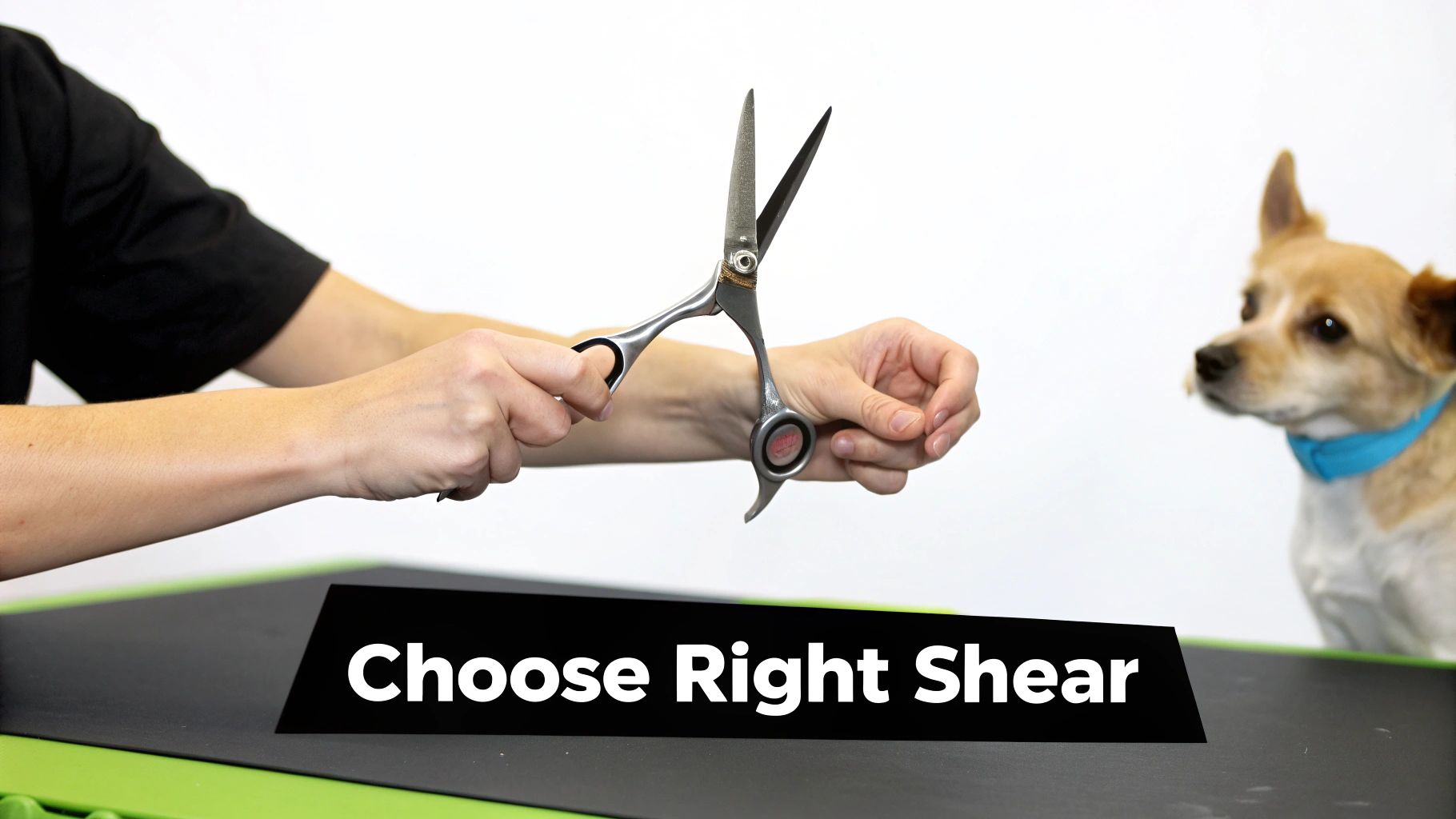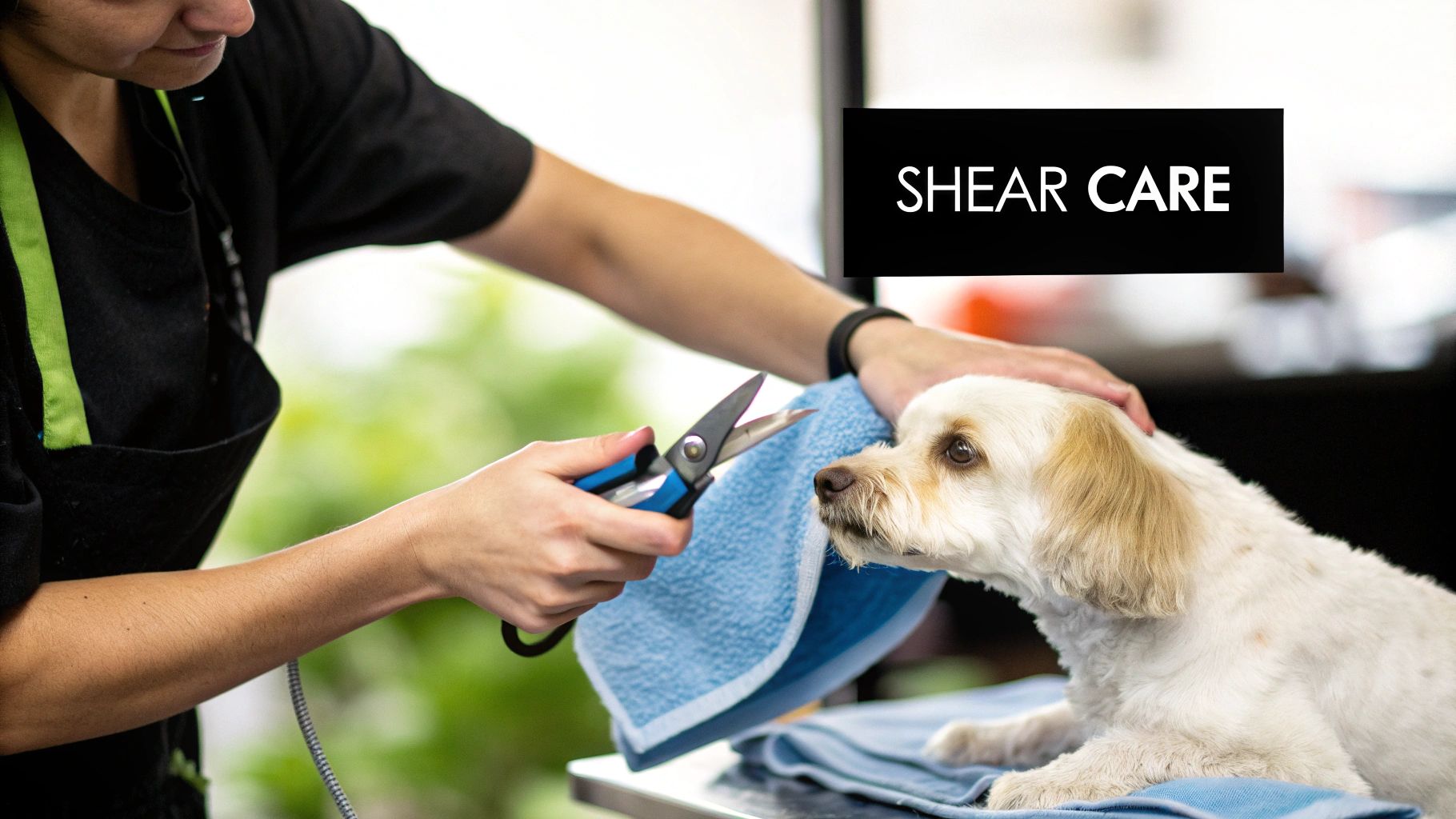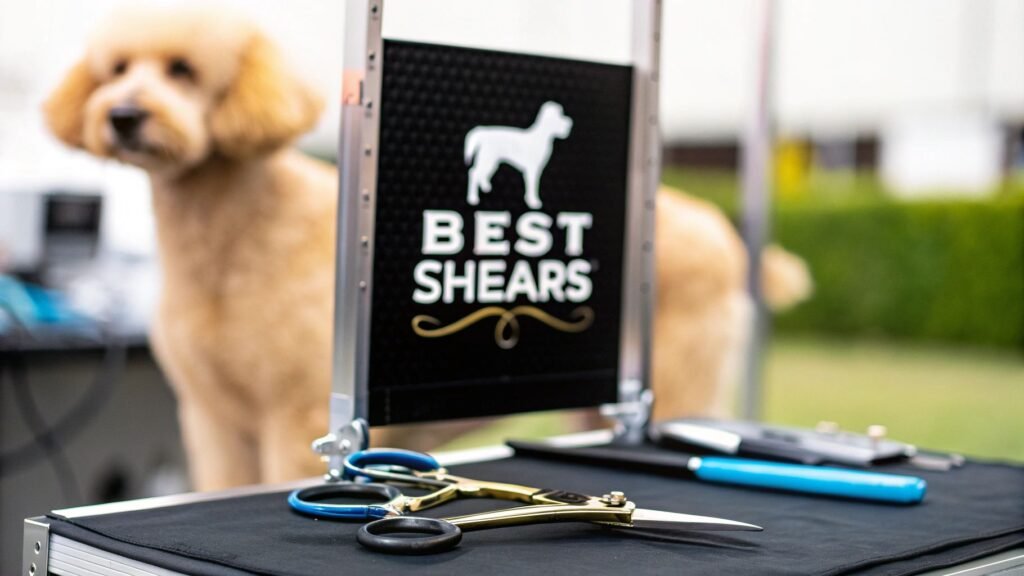Choosing the Best Dog Grooming Shears

If you’ve ever tried to give your dog a quick trim with a pair of kitchen scissors, you already know the struggle. It’s a frustrating, often messy process that can leave your dog looking choppy and feeling anxious. That’s because regular scissors just aren’t built for the job.
Dog grooming shears are in a league of their own. These aren’t just glorified scissors; they’re specialized tools engineered to glide through fur safely and efficiently, giving you that clean, professional finish while keeping your dog comfortable. Using the right shears is the difference between pulling fur and a smooth cut—and trust me, your dog knows the difference.
Why the Right Shears Matter for Your Dog
Think about it this way: a professional chef wouldn’t use a dull butter knife to slice a tomato. It would crush it, make a mess, and ruin the final dish. The same logic applies to grooming. Using the wrong tool for your dog’s coat is clumsy, ineffective, and can turn a simple trim into a stressful ordeal for both of you.
Dedicated dog grooming shears are designed to handle everything from fine, silky fur to thick, wiry coats without a hitch. Unlike household scissors that can snag and painfully pull hair, a quality pair of shears makes a clean cut. This not only prevents anxiety but also seals the hair cuticle, which helps promote a healthier, shinier coat in the long run.
Understanding the Anatomy of a Shear
To really get why one pair of shears is better than another for a specific job, it helps to know what you’re looking at. Just like knowing the basics of a car helps you be a better driver, understanding the parts of your shears will help you become a better groomer.
Let’s break down the key components you’ll find on most grooming shears:
- Blades: This is the business end of the tool. The length, shape (straight, curved, or thinning), and edge type all dictate what kind of cut you’ll get.
- Tension Screw: This is the small, adjustable knob where the blades pivot. Getting the tension just right is crucial. Too loose, and the shears will fold the hair; too tight, and they’ll wear out quickly and tire your hand.
- Handles (or Shanks): This is where your thumb and fingers go. The design here is all about comfort and control, with different styles available to prevent your hand from cramping up during longer grooming sessions.
- Finger Rest (or Tang): That little metal hook extending from the finger loop? That’s the finger rest. It gives you extra stability and leverage, allowing for more precise cuts with less effort.
Once you get a handle on these basic parts, you can start to see why different shears are built for different tasks. It’s the first step to confidently picking the right tool for your dog’s specific needs.
Ultimately, choosing the right shears is a small investment in your dog’s well-being. It turns what could be a dreaded chore into a positive bonding experience, ensuring your best friend not only looks great but feels great, too.
Decoding the Different Types of Grooming Shears
Walking into the world of dog grooming shears feels a lot like stepping into an artist’s studio. You’re surrounded by all these different tools, and you quickly realize each one has a very specific job. Just like a painter wouldn’t use a massive brush for tiny details, a groomer needs a whole collection of shears to sculpt a polished, well-proportioned look.
Each type is designed for a distinct task, whether it’s roughing out the main silhouette or delicately blending out harsh scissor marks for a soft, natural finish. Getting a handle on these different tools is what separates a basic trim from a professional-quality groom. It’s all about picking the right instrument for the right part of the job.

As you can see, a few key players—straight, curved, and thinning/chunker shears—make up the foundation of any serious grooming kit. Let’s break down what each one does.
Straight Shears: The All-Purpose Workhorse
Think of straight shears as the absolute foundation of your grooming toolkit. These are your go-to, versatile workhorses for the bulk of the cutting and shaping. Their main purpose is to create clean, straight lines and set the basic structure of the haircut, which is especially important on dogs with flat coats.
Straight shears are what you’ll grab for trimming large sections like the back, sides, and legs. They come in all sorts of lengths; longer blades help you make quick work of big dogs, while shorter ones give you more control for smaller pups or detail work. If you’re just starting out, a quality pair of straight shears is the first and most critical investment you can make.
Curved Shears: For Precision Contouring
While your straight shears build the frame, your curved shears are the fine-tuning tool you’ll use to add the artistry. The blades have a gentle arc that’s perfectly designed to follow the natural curves of a dog’s body.
You’ll use them to create those beautifully rounded shapes that are just about impossible to get right with a straight blade. They are essential for:
- Paws: Nailing that neat, rounded “cat foot” look.
- Faces: Safely snipping around the eyes and shaping a fluffy teddy bear head.
- Topknots: Perfecting the dome on breeds like Poodles and Bichon Frises.
- Rib Cages and Rears: Blending the coat smoothly around the body’s curves.
Honestly, getting a soft, well-rounded finish is next to impossible without a good pair of curved shears. They let you sculpt the coat with precision, creating a fluid, natural look instead of one with sharp, angular lines.
Thinning and Blending Shears: The Secret to a Natural Finish
Ever wonder how a professional groom looks so soft and seamless, with zero tell-tale scissor marks? That’s the magic of thinning shears, often called blenders. These shears are unique—they have one solid blade and one blade with teeth. This design allows them to remove bulk without sacrificing length.
They’re perfect for softening any harsh lines left behind by your straight shears, blending different coat lengths together, and thinning out areas that are just too dense. On a Golden Retriever’s feathery legs, for instance, thinning shears can lighten the coat for a much more natural appearance.
The name of the game with thinning shears is subtlety. They don’t really cut in the traditional sense; they texturize. This makes them an invaluable tool for erasing mistakes and achieving a finish that looks like the dog’s coat just grew that way.
Chunker Shears: For Texture and Speed
Chunker shears are basically a more aggressive version of thinning shears. Both of their blades have teeth, but the teeth are spaced much wider apart. This lets them remove more hair—or “chunks”—with every snip. The result is a softer, more textured look than you’d get from straight shears, but they work much faster than traditional thinners.
Groomers often reach for chunkers on curly or wiry coats to add texture and shape without leaving the blunt, choppy marks that straight scissors can. They’re a fantastic tool that bridges the gap between shaping and blending.
The growing popularity of specialized tools like these is part of a bigger picture. The U.S. pet grooming services market was valued at USD 2.06 billion and is projected to climb to USD 2.99 billion by 2030. That growth is fueled by the 45.5% of American households that own a dog. You can read more about the growing pet grooming market and what it means for pet owners.
To make it even clearer, here’s a quick cheat sheet that breaks down what each type of shear is best for.
Dog Grooming Shear Types and Their Uses
| Shear Type | Primary Function | Best For |
|---|---|---|
| Straight Shears | Creating straight lines, setting patterns, bulk cutting | Trimming large body areas like the back and sides; establishing the overall haircut shape on flat or straight coats. |
| Curved Shears | Shaping and contouring curved areas | Rounding paws, shaping faces and heads (like a teddy bear look), and contouring around the rib cage and rear. |
| Thinning/Blending Shears | Removing bulk, softening lines, blending | Erasing scissor marks, thinning dense undercoats, and creating a soft, natural finish without losing length. |
| Chunker Shears | Texturizing, shaping, and faster bulk removal | Adding texture to wiry or curly coats, quickly removing bulk, and bridging the gap between shaping and finishing. |
Having this lineup in your toolkit gives you the versatility you need to tackle just about any coat type and achieve that polished, professional look.
How Blade Material and Design Impact Performance
You can have the fanciest-looking shears in the world, but what truly separates a good tool from a great one comes down to the blade itself. The steel it’s made from and the type of edge it has are the two biggest factors that determine how well it cuts, how long it stays sharp, and ultimately, how long your investment will last. Once you get a handle on these details, you can pick shears that perform beautifully right out of the box and for years to come.
Think about a good set of kitchen knives. You’ve got your sturdy chef’s knife for all the heavy chopping and a razor-thin slicing knife for those perfect, clean cuts. Dog grooming shears work on a similar principle, and they mostly fall into two camps when it comes to the blade edge.

Beveled Edges: The Durable Workhorse
The beveled edge is the most common design you’ll see, especially on shears for beginners or for groomers who need a reliable daily driver. On these, one or both blades have a very distinct, flat angle ground into the cutting edge. This simple design creates an incredibly tough and durable edge that can take the abuse of cutting through thick, coarse, or even slightly dirty fur without getting easily damaged.
A beveled edge is like a trusty wood-splitting axe—it’s strong, reliable, and built to handle tough jobs. They might not give you that whisper-quiet, buttery-smooth cut, but they’re fantastic for bulk work and general-purpose grooming. You’ll often find that one of the blades has tiny micro-serrations, which are great for gripping the hair and stopping it from sliding away as you cut.
Convex Edges: The Precision Instrument
On the other end of the spectrum is the convex edge, sometimes called a clamshell or Japanese-style edge. These things are razor-sharp, honed down to an incredibly fine point. Instead of that flat angle, the blade has a gentle curve that tapers to a microscopic cutting surface. This is the design you’ll find on high-end, professional finishing shears.
If a beveled edge is an axe, a convex edge is a surgeon’s scalpel. It glides through hair with almost zero effort, leaving behind a perfectly smooth finish. This makes them the go-to choice for detailed finishing work, creating flawless blends, and any precision styling where the quality of the cut is paramount. That incredible sharpness does come with a trade-off, though; the delicate edge is much more prone to nicks and requires a specialized sharpening service to maintain.
The choice between beveled and convex isn’t about which is “better,” but which is right for the task. A beveled edge provides durability for everyday work, while a convex edge delivers unparalleled smoothness for finishing.
Understanding Shear Materials
Beyond the edge, the metal itself is a huge piece of the puzzle. The quality of the steel is what dictates how long your shears will hold an edge, how well they resist rust, and their overall lifespan.
Most grooming shears are made of stainless steel, but not all stainless steel is the same. The quality is often tied to a hardness rating, and different steel alloys bring different strengths to the table:
- Japanese 440C Stainless Steel: This is pretty much the gold standard for high-quality shears. It strikes a fantastic balance between hardness, durability, and corrosion resistance, which means it can hold a razor-sharp convex edge for a very long time. Shears made from 440C are a true long-term investment.
- Cobalt Alloys: When cobalt is added to the steel mix, it makes the metal significantly harder and stronger. Cobalt-infused shears are exceptionally tough and stay sharp even longer than standard stainless steel. This makes them a favorite among professional groomers who are using their tools all day, every day.
- Titanium Coatings: You’ll see some shears with a colorful titanium coating over the steel. This isn’t just for looks (though the rainbow, blue, or black finishes are cool). The coating adds another layer of defense against rust and makes the surface harder and more resistant to wear and tear.
When you get right down to it, the blade’s material and edge are the engine of your shears. By understanding how these two elements work together, you can confidently choose a tool that not only gives you a beautiful cut but will also stand the test of time.
Finding the Perfect Fit for Ergonomics and Comfort
A razor-sharp blade is a great start, but it’s only half the story when it comes to exceptional dog grooming shears. The best pair will feel like a natural extension of your own hand, letting you work for hours without cramping up. The handle design—what we call ergonomics—is the single biggest factor in your comfort and control, and it’s your best defense against hand fatigue and repetitive strain injuries.
If you’ve ever tried to run in shoes that don’t fit, you know how quickly blisters and pain can ruin the experience. It’s the exact same principle with shears. The wrong handle design forces your hand into an awkward position, leading to soreness and a shaky grip, turning a grooming session into a struggle. Choosing shears that fit your hand well isn’t just a luxury; it’s an investment in your own well-being and the quality of your work.

It’s clear that groomers and pet owners are catching on. The global market for pet grooming shears was valued at around USD 275 million recently and is on track to hit nearly USD 450 million by 2032. This boom is all thanks to more people bringing pets into their homes and wanting professional-grade tools to care for them. You can discover more about the growing market for pet grooming shears and see just how big the industry is getting.
Comparing Common Handle Designs
You’ll generally run into three main handle styles. Each one puts your hand in a slightly different position, so understanding the pros and cons will help you find your perfect match.
- Opposing Grip (Traditional): This is the classic, old-school design. The finger and thumb holes are perfectly symmetrical and sit directly across from each other. They’re straightforward and often cheaper, but they make your thumb do a lot of extra work, which can really strain your hand after a while. This grip is fine for a quick, occasional trim, but not much more.
- Offset Grip: Here’s where comfort really starts to improve. An offset grip has a shorter thumb handle, which lets your hand rest in a more open, natural position. This simple change drastically cuts down on how much your thumb has to move, taking a ton of stress off your tendons. It’s a fantastic middle-ground and a popular choice for both serious home groomers and pros.
- Crane Grip: For the ultimate in ergonomic design, look no further. The crane grip features a sharply angled thumb ring and a dropped finger handle. This lets you lower your entire arm, keeping your elbow and shoulder relaxed. It’s the gold standard for comfort and is pretty much essential for professional groomers or anyone spending hours on end with shears in hand.
The right handle isn’t just a feature—it’s a necessity. A comfortable, steady grip gives you better control over the blades, which means a safer, cleaner, and more precise cut for your dog every single time.
Finding Your Ideal Fit
So, which one is for you? It really comes down to what feels best in your hand and how much grooming you do.
If you’re just doing quick touch-ups around the face or paws, a simple opposing or offset grip will probably do the trick. But if you’re tackling full-body grooms or working on multiple dogs, spending a little extra on an offset or crane grip will pay you back tenfold in comfort.
Remember, while you’re focused on keeping your dog comfortable during the trim, your own comfort is just as crucial. A relaxed, steady hand is the secret to a beautiful groom. Having the right tools for the job is about more than just sharp blades; it’s about the complete setup, including keeping your dog secure with our selection of high-quality collars, leashes, and harnesses.
Finding the Right Shears for Your Dog’s Coat
Alright, we’ve covered the different types of shears, from the blades to the handles. Now comes the fun part: putting that knowledge to work and picking the right tools for your specific dog.
This isn’t a one-size-fits-all situation. The shears that work wonders on a Poodle will be completely wrong for a German Shepherd. Using the right tool for your dog’s coat is the secret to a great-looking, stress-free groom. It’s like being a chef—you need the right knife for the job. You wouldn’t try to filet a fish with a bread knife, would you?
Let’s break down which shears you’ll need for the most common coat types.
For Smooth and Short Coats
Think Beagles, Boxers, or Great Danes. These dogs have sleek, short coats that don’t need a full-body haircut, but they definitely need some tidying up around the edges.
Your go-to tool here will be a shorter pair of straight shears, something in the 6-7 inch range. They’re perfect for creating clean, sharp lines around the paws, ears, and tail. I also highly recommend a small pair of ball-tip or safety-tip curved shears. These are a lifesaver for trimming hair between paw pads and around the face without any risk of poking your pup.
For Dense Double Coats
We’re talking about breeds like Golden Retrievers, Huskies, and German Shepherds. Their coats are made of two layers: a soft, dense undercoat for insulation and a tougher, longer topcoat for protection. The name of the game here is managing bulk, not chopping off length.
Your absolute best friend will be a good pair of thinning shears. These are brilliant for removing some of that bulky undercoat without leaving obvious scissor marks in the topcoat. You can use them to lighten up the heavy areas around the neck and hindquarters for a beautifully blended, natural look. For breeds with notoriously thick coats like Labs, the right shears need to be paired with effective deshedding tools. To round out your grooming kit, take a look at our guide on the best brushes for Labrador Retrievers.
With double-coated dogs, always remember this golden rule: You want to de-bulk, not shorten. Thinning shears help you preserve the coat’s natural function and appearance while making it much more manageable.
For Curly and Wavy Coats
This is Poodle, Bichon Frisé, and Doodle territory. These dogs have coats that grow continuously and need regular, skilled shaping to look their best. Grooming these breeds is a true art form, and you’ll need a few different shears in your arsenal.
The undisputed MVP for curly coats is a great pair of curved shears. They are essential for shaping those classic rounded topknots, following the body’s contours, and getting that perfect “teddy bear” face. You’ll also need straight shears for setting the basic lines on the body and legs, while chunker shears are fantastic for texturizing and quickly removing bulk without leaving harsh lines. Using all three is how you achieve that soft, fluffy, professional-looking finish.
For Wiry Coats
Terriers like Schnauzers and Airedales have that signature coarse, wiry topcoat and a softer undercoat. While hand-stripping is a common technique for these breeds, shears are still crucial for the finishing touches.
The perfect combo here is a set of straight shears and thinning shears. Use the straights to sculpt the sharp, angular lines on the legs, beard, and eyebrows that define the classic terrier look. Then, grab your thinners to soften and blend any harsh lines, especially where the trimmed body coat meets the longer leg furnishings. The goal is a crisp, clean silhouette that really shows off the dog’s structure.
This focus on specialized tools is part of a much bigger picture. The professional pet electric grooming scissors market is currently valued at around USD 500 million and is projected to grow at a 7% CAGR. This boom is fueled by what’s known as the “pet humanization” trend—owners are simply investing more in their pets’ well-being and appearance. You can read more about the professional pet grooming tool market to see just how quickly it’s expanding.
Keeping Your Shears in Top Condition
High-quality dog grooming shears are a real investment in your craft, and just like a chef protects their best knife, you need to protect your tools. Good maintenance isn’t just about making them last longer; it ensures every snip is clean and safe, keeping the dog comfortable and your hands from getting tired.
If you let them go, you’ll end up with rusty, dull blades that pull hair and make your job ten times harder. The good news? A simple daily routine is all it takes to keep them working like new for years to come.
The Daily Clean-Up
After each groom, set aside a minute for a quick clean-up. This tiny habit is your best defense against the gunk—hair, dander, and styling products—that can corrode the blades and mess with the pivot screw.
- Wipe the Blades: Grab a soft, dry cloth and give both the inside and outside of the blades a thorough wipe. Get all that lingering hair and moisture off.
- Clear the Pivot: Open your shears wide and clean around the screw. This is where tiny hairs love to hide, and that buildup can make the blades feel sticky.
- A Drop of Oil: Put a single, small drop of shear oil right at the pivot point where the blades meet. Snip them open and closed a few times to spread the oil evenly, then wipe off any excess.
This whole process takes less than a minute, but it makes a huge difference in how smoothly your shears operate. It’s the best way to fight off rust and wear. While you’re at it, stocking up on other essential grooming and cleaning supplies can help you keep every part of your pet looking and feeling fantastic.
Tension Checks and Professional Sharpening
Tension is one of those things that’s easy to forget but critical to performance. That little screw isn’t just for show; it controls how tightly the blades press together. Get the tension wrong, and even the most expensive shears will fold hair instead of cutting it.
Here’s a quick way to check: Hold one handle with the thumb ring pointing up. Lift the other handle until the blade is straight up, then let it go. The blade should drop and close about two-thirds of the way. If it slams shut, it’s too loose. If it barely budges, it’s way too tight.
No matter how well you care for your shears, they will eventually get dull. Don’t be tempted to sharpen them yourself! It’s a surefire way to ruin the delicate edge, especially on convex shears. A professional has the right equipment to bring back that factory-sharp edge without damaging the blade.
How often? If you’re grooming at home, once a year is probably fine. For professional groomers handling multiple dogs a day, you might need a sharpening every 3-6 months. You’ll know it’s time when your shears start bending or pushing the hair instead of making that satisfying, clean snip.
Got Questions? We’ve Got Answers.
Even after you’ve wrapped your head around all the different types of dog grooming shears, a few questions might still be nagging at you. That’s totally normal! Let’s clear up some of the most common things people ask when they’re getting started.
Think of this as a quick chat with an expert to iron out those final details. The goal here is to make sure you feel confident you’re picking the right tools and using them safely to get that perfect, fluffy finish.
Can I Just Use My Hair Scissors on My Dog?
This is probably the number one question we hear, and the answer is a firm “no.” It might seem like scissors are just scissors, but that couldn’t be further from the truth. Human hair scissors are built for our fine, straight hair, while dog grooming shears are engineered for a much tougher, more varied job.
Shears made for dogs often have special features, like tiny micro-serrations on the blade, that are designed to grip coarse fur so it doesn’t just push away. They’re built from more robust materials, and the handles are shaped to prevent your hand from cramping up while you maneuver around a dog’s body. Trying to use the wrong tool isn’t just frustrating—it can painfully pull your dog’s fur and leave you with a choppy, uneven mess.
Remember, using proper dog grooming shears isn’t just about a better-looking haircut. It’s about keeping your dog safe and comfortable. They are fundamentally different tools for very different tasks.
How Often Should I Get My Shears Sharpened?
Keeping your shears sharp is non-negotiable for a good groom. Once a blade starts getting dull, it will bend and push the hair instead of slicing through it. That’s a recipe for a bad time for both you and your pup.
How often you need a professional sharpening really just comes down to how much you use them:
- For Home Groomers: If you’re just doing touch-ups on your own dog every now and then, having them professionally sharpened once a year is usually plenty to keep them in great shape.
- For Professional Groomers: When you’re grooming dogs all day, every day, you’ll want to send your shears in for sharpening every 3 to 6 months to maintain that perfectly crisp, clean cut.
Are Thinning Shears Good for Every Coat Type?
Thinning shears are miracle workers for softening harsh lines and reducing bulk, but they definitely aren’t a one-size-fits-all tool. Their magic really depends on the kind of coat you’re working with.
They shine on dogs with thick or double coats—think Golden Retrievers, German Shepherds, or Bernese Mountain Dogs. On these breeds, they can lighten the dense undercoat without ruining the length of the topcoat. On the flip side, you want to be very careful using them on dogs with thin or silky coats, like a Yorkie or a Maltese. Going overboard on fine fur can quickly create a patchy, sparse look. Used correctly, they leave behind a beautifully soft, natural-looking finish.
At Ur Pet Store, we know that the right tools are half the battle. Ready to find the perfect pair for your best friend? Come explore our collection of premium grooming supplies.
Find the perfect shears at Ur Pet Store


